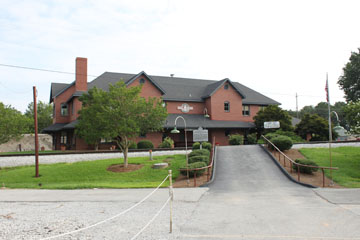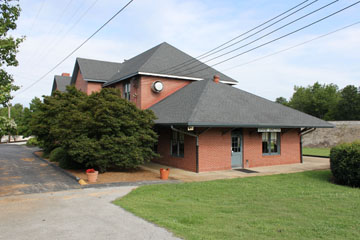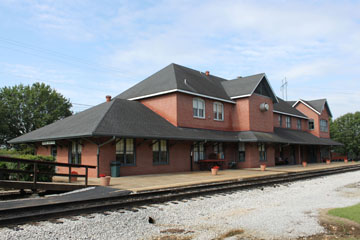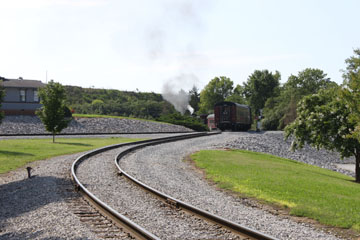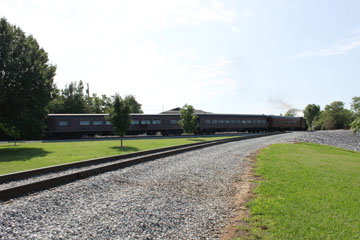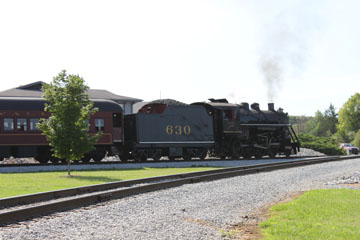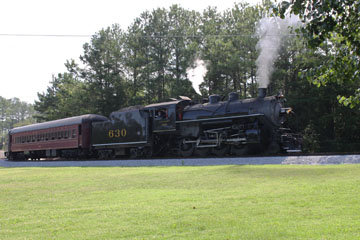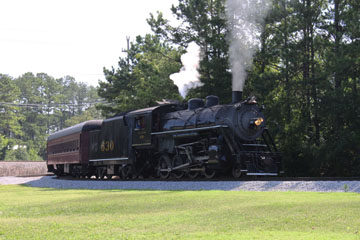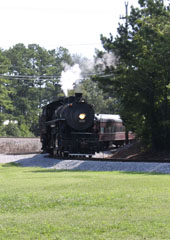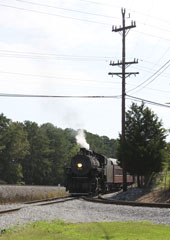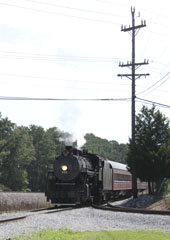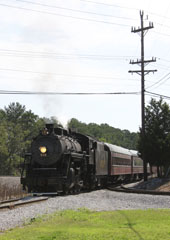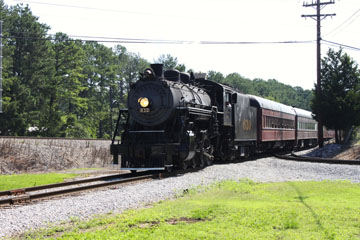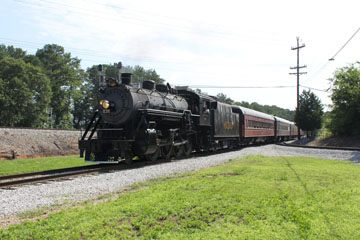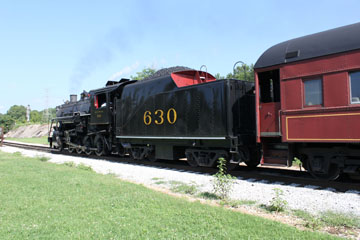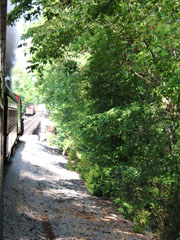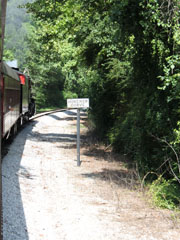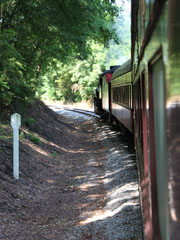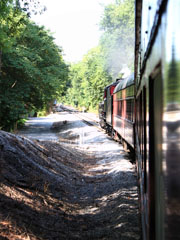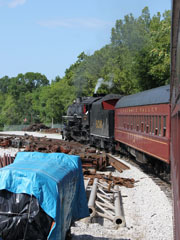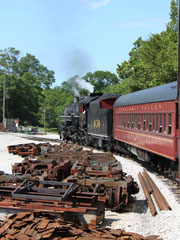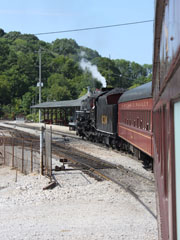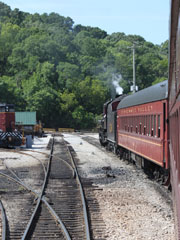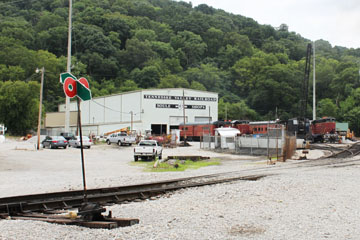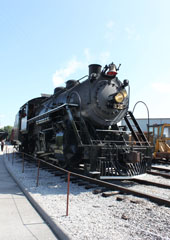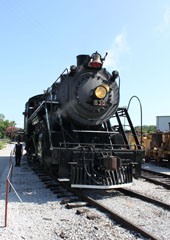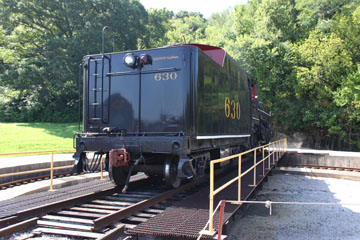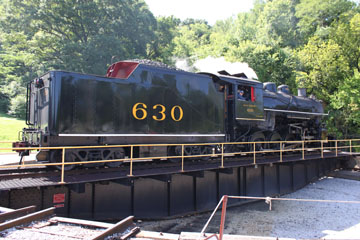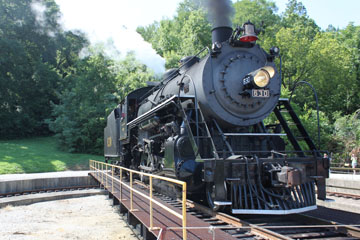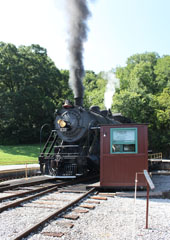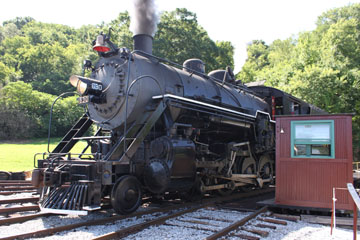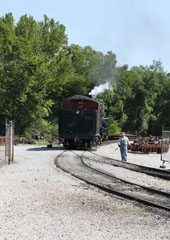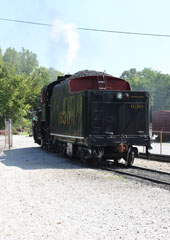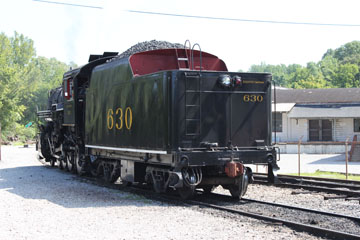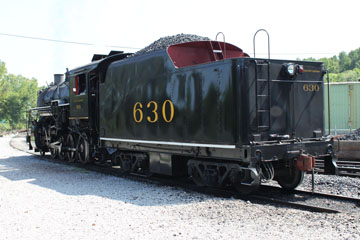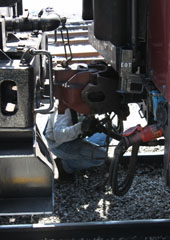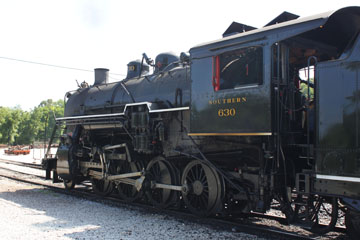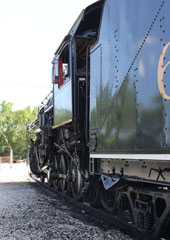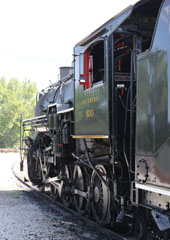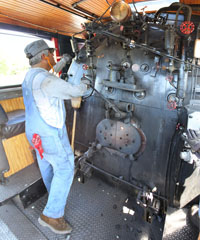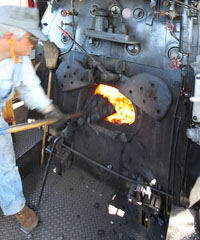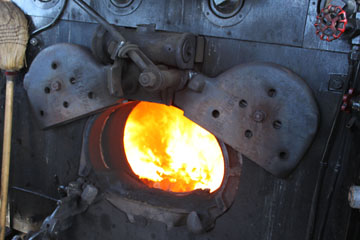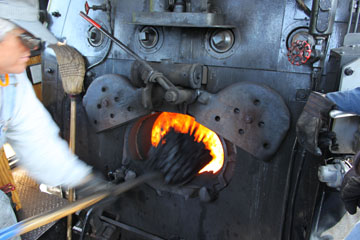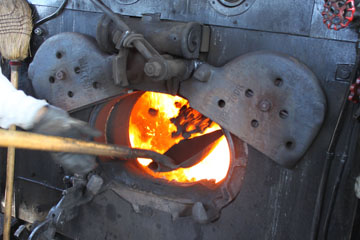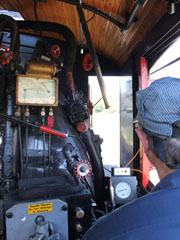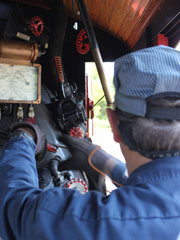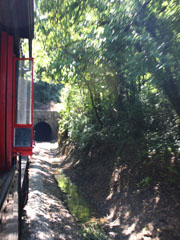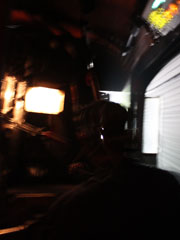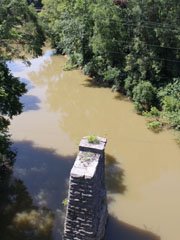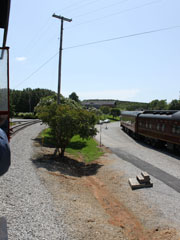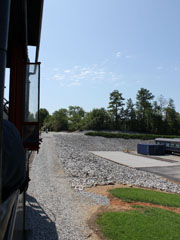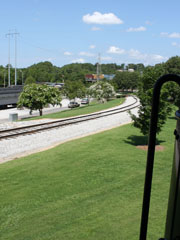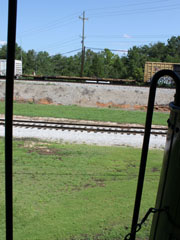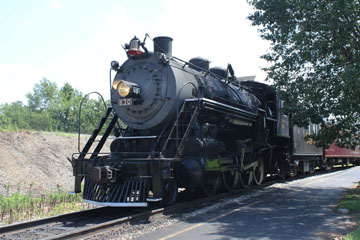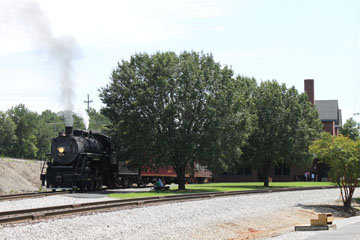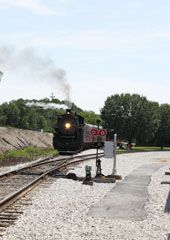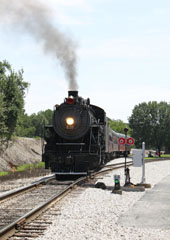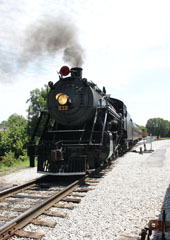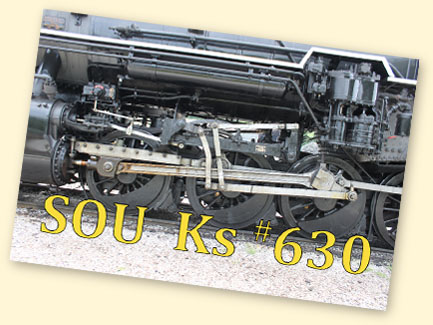

The Tennessee Valley Rail Road is not a typical museum with an entrance fee, buildings and yards full of static displays. It is the largest operating historic railroad in the South, and relies on income from its various excursions, including the Chickamauga Turn from Chattanooga, TN, to Chickamauga, GA, all-day excursions from Chattanooga, TN, to Summerville, GA, and trips over the former Louisville & Nashville "Hook and Eye" line between Etowah and Copperhill, TN.
Passenger trains also run every day from April to October on a route through the eastern part of the city of Chattanooga. The Missionary Ridge Local begins at the Grand Junction Station and takes passengers along one of the original railroad lines in Chattanooga, crossing four bridges and passing through pre-Civil War Missionary Ridge Tunnel, completed in 1858. The train stops at East Chattanooga, where the locomotive is turned on a turntable and passengers can take a tour of the railroad's restoration shop before re-boarding for the return trip. The round trip takes a little less than an hour.
You can see other equipment in the collection on the Tennessee Valley Rail Road page of this website.

The original depot functioned as a district headquarters for the M&C between Memphis and Chattanooga, TN, and became part of the
Southern Railway system after merger in 1894. The Southern abandoned the depot in 1946 and donated the building to the city of Tuscumbia when it built a new depot about a mile north of the original.
The building now serves as headquarters for the Tuscumbia Railway Co., which operates a small scale steam train at the site, as well as a museum for Tuscumbia and its history.
TVRRM's Grand
Junction depot was built in 1983 and is a based on the one on 5th Street
in Tuscumbia, AL, although it also has a ticket office, restaurant, gift shop, theatre and offices.
Right, the train timetable bulletin board is displayed at the depot.
The right of way used by the Missionary Ridge Local was started by the Chattanooga, Harrison, Georgetown & Charleston Railroad in the 1850s. After the CHG&C went bankrupt it was taken over by the East Tennessee & Georgia Railroad and became part of its Chattanooga Branch. The ET&G connected Knoxville, TN, with Dalton, GA.
In 1869, the ET&G was consolidated with the East Tennessee & Virginia Railroad, which connected Knoxville with Bristol, TN, to form the East Tennessee, Virginia & Georgia Railroad. The ETV&G bought other rail lines across the region and, by 1890, controlled over 2,500 miles of track in five states. Like the M&C, it became part of the Southern Railway system in 1894.
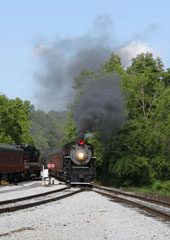
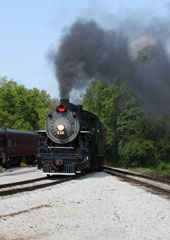
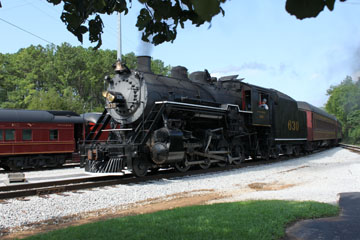
Above, SOU K #630 pulls into Grand Junction
from East Chattanooga where it has rested overnight. The locomotive needs to be reversed to make the return trip so, right, it passes through a wye before pulling up at the depot to take on passengers.
#630 is a Consolidation (2-8-0) type locomotive built for the Southern Railway in 1904 by Alco's Richmond, VA, works. It is one of one hundred and thirty K class locomotives built by Alco at its Richmond and Pittsburgh, PA, works, as well as by Baldwin. They preceded four hundred and forty-three more, revised K-series engines produced by Alco and Baldwin for the Southern and its subsidiaries in 1905 and 1906.
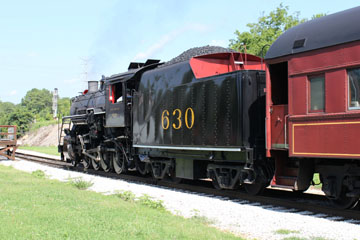
Above, #630 pulls up to the depot platform.
#630 and #722, another K, were sold to the East Tennessee & Western North Carolina Railroad in 1952 as their #207 and #208. They were used to switch cars in and around Johnson City, TN, until traded back to the Southern in 1967 in return for two former Central of Georgia Alco RS-3s. The two steam locomotives then headed main line excursions over the entire Southern system until 1983 when both were retired and leased to the Tennessee Valley Railroad Museum. #722 was later loaned to the Asheville Chapter of the National Railway Historical Society by Southern's successor, Norfolk Southern. The TVRRM ran #630 until 1989 when it was again retired.
#630 was donated to the museum in 1999 by the Norfolk Southern and, soon after, began one of the most thorough restorations performed on a steam locomotive in the US up to that time. The work included boring the valve and piston cylinders, reboring and bushing spring and brake rigging holes, replacing boiler studs, new tires, cast driving boxes, tube sheet, a section of the first boiler course, delivery pipes and smoke box.
#630 returned to service in 2011, and has since participated in Norfolk Southern's "21st Century Steam" program.



Above, crossing South Chikamauga Creek just outside the Grand Junction yard.
Below, about a mile further along, we pass through Hunziker Curve. The curve was named in memory of one the museum's founder members whose ashes were spread here.
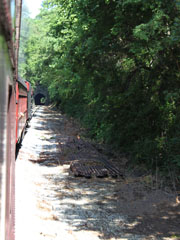
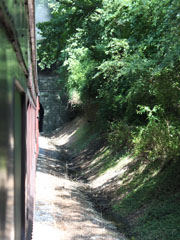
Approaching Missionary Ridge Tunnel.
It was started by the Chattanooga, Harrison, Georgetown & Charleston but completed by the East Tennessee & Georgia. The railroad named it Whiteside Tunnel after Col., James A. Whiteside, a well known Chattanoogan and major stockholder of the East Tennessee & Georgia.

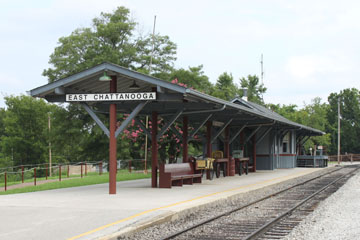
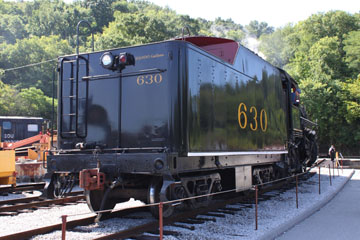
The depot at East Chattanooga was built in 1980. Just as the Southern Railway depot in Athens, TN, was being demolished, the museum was able to salvage the arch braces to use on the platform canopy at East Chattanooga. As the Missionary Ridge Local turns here, there is no staffed ticket office.
Below, East Chattanooga is, however, the location of the museum's main restoration shops, storage, maintenance of way and repair facilities. These were built during a period of major expansion during the 1980s.
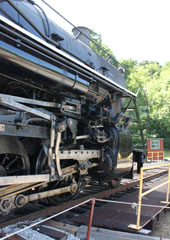
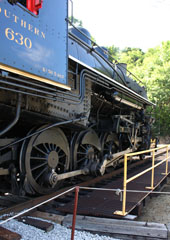
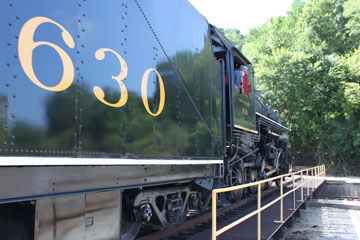
Above, #630 eases onto the turntable.
The 80' diameter turntable was originally built in 1916 by the American Bridge and Iron Company of Ambridge, PA, for the Central of Georgia Roundhouse in Macon, GA. As steam locomotives grew in size, however, it eventually became too small for the Macon Roundhouse's needs, and it was then moved to Cedartown, GA. With the
arrival of diesel power, there was no longer any need for a turntable and it was then donated as is to the TVRRM. The museum arranged to transport it the ninety miles from Cedartown to East Chattanooga and spent $105,000 on this, as well as repairing it for use. It was placed into service on 4th July 1982.

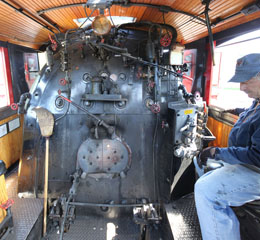
On the return trip, I was able to ride in the cab. It's a short trip but, even at $25, it's amazing value!
#630 has a 53.57 sq ft grate but quite a small, 143 sq ft firebox. The boiler has four hundred and thirty-seven tubes, thirty-four more than the large batch of Ks that followed in 1905/06. With a total heating surface of 3,517 sq ft and, operating at a boiler pressure of 200 psi, it delivers 44,079 lbs tractive effort.
Like many Ks, #630 received a refit in which the Universal valve chest with piston valve was simply bolted onto the square slide-valve casting, and its Stephenson valve gear was replaced by Southern valve gear. This was devised by designers on the Southern in the early 1900s.
The engine weighs 199,875 lbs, 176,750 lbs on its 56" drivers, with 22" x 30" cylinders. The current tender is larger than the original, 183,200 lbs light with a 10,000 gallon water and 16 ton coal capacity.

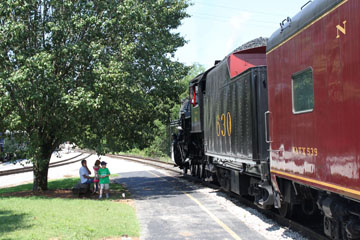
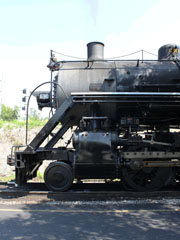

Missionary Ridge Tunnel is the main reason the train runs on this three mile section.
As railroad equipment grew too large to pass through and the single-track tunnel became a traffic jam for an otherwise double-track system, Southern built a new section around the end of Missionary Ridge and abandoned the tunnel altogether.


